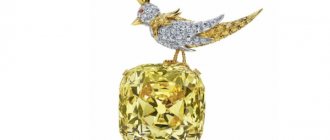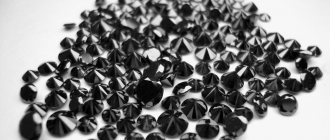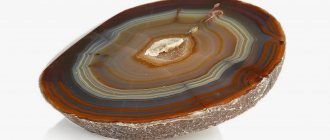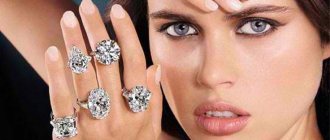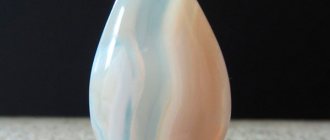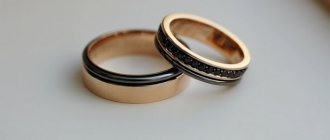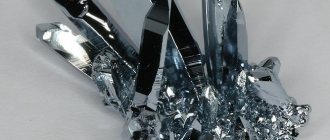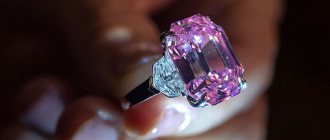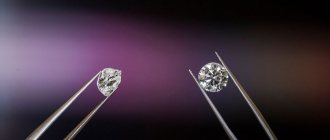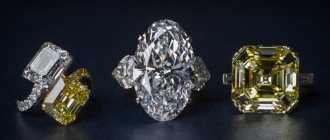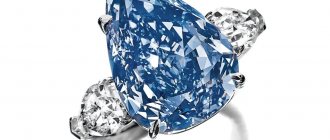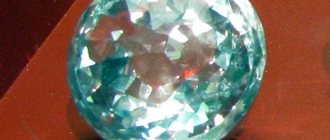Brown diamonds are the “Cinderellas” in a sparkling sea of gems. Previously, they “worked” peacefully in industry: only the rarest of them entered the mineral elite and were honored with the touch of the hands of jewelers. However, at the beginning of the 21st century, a real fairy tale began for the humble brown diamond.
Cognac diamonds
Pasquale Bruni played the role of the fairy. At an exhibition in Basel, a talented designer and jeweler presented jewelry made of brown diamonds to the general public. The yellow gold setting perfectly complemented the stones with the warm color of aged cognac. Then the brown diamond was called “cognac”.
Physical and chemical properties
Cognac diamonds are naturally brown diamonds. A colorless diamond is made of pure carbon. Brown specimens are formed due to the fact that, under constant and prolonged exposure to pressure and high temperature, slight deformation of the crystal lattice occurs. During the transformation, atoms of iron, nitrogen and nickel are built into it. Their percentage ratio determines the shade and saturation of the brown color.
| Formula | C |
| Color | All shades of brown, brown-yellow, brown-orange, coffee, chocolate and others |
| Probable impurities | Iron, nickel, nitrogen |
| Shine | Diamond |
| Hardness | 10 |
| Transparency | Transparent |
| Strength | Lasting |
| Kink | Conchoidal to splintery |
| Cleavage | Perfect by (111) |
| Density | 3.47-3.55 g/cm3 |
| singonia | Cubic |
| Refractive index | 2,417-2,419 |
Blue color of the stone
The blue diamond is rightfully considered to be the privilege of the elite; its extraordinary bewitching beauty and rarity have ensured its fame as an elite jewel. Of course, we are talking only about blue diamonds, and not about artificially refined cape diamonds.
The last traditional shade of the stone is affected by high pressure or temperature, as a result of which the diamond appears in a typical fancy shade. Accordingly, such stones are valued an order of magnitude lower than natural colored diamonds; a diamond subjected to such processing is even lower than a colorless one.
The reason for such a low cost lies in the choice of mineral for refining. First of all, preference in terms of quality is given to stones whose diamond characteristics are very mediocre. In this regard, jewelry with inexpensive, ennobled blue diamond stones appears more often on the shelves of jewelry stores.
Varieties of Brown Diamonds
Cognac diamonds are divided into two groups:
- Elite – which includes all fancy diamonds (blue, red and others). Browns in this group are considered the cheapest.
- Cape - yellow-brown gemstones, also called Cognac Diamond.
For convenience, jewelers divided cognac diamonds into the following types based on color:
- Chocolate – dark brown stones of a “delicious” chocolate color.
- Champagne stones are the lightest in their group, pale brown stones.
- Cognac – cognac-brown gems. The most valuable of them have orange tints.
- Walnut - stones the color of a walnut shell.
- Honey or amber are yellowish-orange diamonds.
- Coffee – coffee-with-milk colored stones.
When assessing the quality of a Cognac diamond, the deciding factors are hue (base color), tone (dark or light) and saturation (brightness and depth of color).
Jewelry value
Unlike white diamonds, for colored diamonds the main characteristic that determines the value of the stone is color. It outweighs even mass or purity.
Taking these features into account, a separate rating scale has been developed for colored pebbles, including cognac ones, with the following parameters:
- Hue. Main visible color; brown is welcome.
- Tone. Indicates the gradation of darkness of a hue.
- Saturation. The degree of color intensity. The higher, the more expensive the stone.
Gold ring with cognac diamond
The cost of the stone will skyrocket if the main color – brown – is complemented by orange shades.
Place of Birth
Just a few decades ago, brown diamonds, along with other fancy and colorless diamonds, were mined mainly in Africa.
Now African reserves are practically depleted; colored specimens have not been found for quite some time. The last known deposit is the Argyle mine in Australia, but it is already almost depleted.
Brown diamonds are sometimes found in Brazil, but in very modest quantities.
Turning an outcast into a sales star
Cape diamonds with a brownish color first appeared on the market in the late 70s of the last century, immediately after they were discovered in one of the Australian mines.
Due to their low transparency, brownish-colored diamonds were classified as technical diamonds and were used exclusively for industrial purposes.
A real revolution in the consciousness of the average person was made by the Belgian designer Pasquale Bruni, who presented his jewelry collection at the Basel Fair in 2001. His pendants, pendants, rings and earrings were decorated with cognac- and cinnamon-colored diamonds, which looked very attractive in a yellow gold frame.
A well-executed marketing campaign, reminiscent of the actions of Fawaz Gruosi in advertising black diamonds, made the brown diamond extremely in demand, and its prices instantly increased several times. Read more about the essence of the advertising move in the article “Black Diamonds: What are they?”
This was greatly facilitated by the news that the Australian Argyle mine has practically exhausted its reserves of brown diamonds.
The magical properties of cognac diamonds
The properties of diamonds are reflected in their magic - royal splendor, unshakable hardness and strength. They strive to make their owner the same way:
- Strong physically and spiritually.
- Not giving in to difficulties.
- Brilliant and successful in business.
- Purposeful and resourceful.
- Attractive and sexy.
- Confident and ready for any difficulties.
The king among stones makes its owner a “king” among people.
Not everyone can cope with such power and pressure of diamond energy. Therefore, when choosing a stone as a talisman, astrological compatibility should be taken into account.
A cognac diamond will become a faithful friend to a woman who, for some reason, has become disillusioned with herself and has stopped loving herself. The stone will help her raise self-esteem and believe in her own strength.
Gems in Champagne shades bring harmony to life and peace to the soul. Yellow stones attract money, and brown stones attract the attention of others.
Criteria for evaluation
As when choosing transparent diamonds, you should definitely pay attention to the quality of the cut of the specimen, its weight, shape, clarity and, of course, color. Fancy stones increase in value depending on the intensity of color within a certain color. Those diamonds that do not have auxiliary colors in their structure are valued higher. For example, a stone of pure yellow color will be valued 2 times more expensive than a similar one, but with an admixture of brown. Interestingly, it is the brown and yellow colors that significantly reduce the cost of stones, and the increase in their prices today is only due to the popularity of the mineral imposed by jewelers.
Medicinal properties
Cognac diamonds, like all others, carry powerful energy and have a positive effect on the entire human body. Lithotherapists are confident that these gems:
- Slow down aging.
- Restore the psycho-emotional background and treat mental disorders. However, if contact is too long, they can, on the contrary, worsen the situation.
- Reduce temperature, reduce inflammation.
- Removes toxins and neutralizes poisons.
- Reduces stomach and intestinal colic.
- Removes mucus during bronchitis and makes breathing easier.
- Clears skin problems, fights various dermatological problems.
- Helps remove kidney stones.
- Cures diseases of the musculoskeletal system.
Dosed wearing of brown-colored diamonds will be useful for absolutely everyone to improve their overall well-being, strengthen the immune system, and lift their spirits.
Authentication by characteristics
To avoid falling for a fake, you need to know how to identify a real diamond. And for this you should remember such characteristics of the stone as:
- Light refraction. It is impossible to see light through a real stone, only the point in the center of the stone, since the beam is reflected from the walls of the pavilion (the lower part of the diamond). If the clarity of the diamond is not ideal, this characteristic will still not be affected.
- The hardness of the jewel. A stone can scratch the glass, and it cannot be damaged by sandpaper.
Tests are also carried out in laboratories using diamond detectors. It is necessary to distinguish real diamonds from moissanites, cubic zirconias and synthetic fakes. Therefore, when purchasing in stores, ask for all documents confirming the origin of the diamond.
If you purchase a stone weighing more than 1.5 carats, then it must be accompanied by an international certificate from the GIA (Gemological Institute of America) or HRD (Diamond Council in Belgium) commissions. Russia has its own assessment system, which, unfortunately, does not meet international standards and is called TU. Stones with less weight do not undergo the evaluation procedure or can undergo it at the request of the buyer for an additional fee.
In any case, a diamond remains the most expensive stone on Earth. Its cost directly depends on the characteristics. Selecting a diamond or a product with this stone is not a matter of one day, since the purchase is expensive and is made for many years. Therefore, the decision must be made as carefully as possible, based not only on your taste, but also on the store’s pricing policy.
Algorithm for the diamond production process
Properties and production technology of artificial diamonds
Types, shapes and quality of diamond cuts
«>
History and characteristics of the Tiffany diamond
Products and decorations
Cognac diamonds are framed exclusively in yellow gold; in metal of other shades, brown stones look faded. In very rare cases, rose gold is used.
Today, the cost of Cognac Diamond group gems per carat is around $4,000. In the near future, experts predict a sharp increase - up to $80,000 per carat, which is associated with a shortage of natural raw materials (brown diamonds) and a constant increase in demand for products with them.
This is interesting!
The bulk of cognac diamonds are up to five carats in size. But there are exceptions to the rules - magnificent stones known in the world:
- “Golden Jubilee” - was presented to the King of Thailand on the 50th anniversary of his coronation, after which he was named. Initially it weighed 755 carats, after cutting it began to weigh 545 carats. Today it is valued at $12 million.
- "Darcy Vargas" - named after the first lady of Brazil, weighs 360 carats.
- “Song of Parana” - discovered in 1937 near the Parana River in Brazil, weighs 245 carats.
Some cognac diamonds have left their mark on history, for example, the Aschberg, which belonged to the Romanov dynasty and was later sold to the banker Aschberg. Or they became famous thanks to cinema - “Victoria Transvaal” (68 carats), “Eastern Star” (111 carats), “Kimberly” (70 carats) and celebrities - “Esther Williams” (Hollywood star of the 40s of the 19th century).
Jewelry assortment
The most affordable for Russian jewelers are brown diamonds from Yakutia. Almost all jewelry contains just such inserts:
- Brown diamonds look best in yellow or rose gold. A white setting (gold or platinum) makes the stone appear paler.
- Gold jewelry with Cognac Diamond is a luxury that suits people of all ages and skin tones. This provides a range of colors from light champagne to dark chocolate.
- Studs or a modest ring with a cognac diamond are appropriate in the office. Luxurious earrings with brown diamonds plus the same ring will suit an elite evening wardrobe. Cufflinks, a tie clip, a ring with a dark stone are noble men's accessories.
Jewelry with cognac diamonds
If you plan to wear several pieces of jewelry at the same time (this is not bad manners for cognac diamonds), you need to choose stones of the same tone.
Prices for Russian gold jewelry with natural cognac diamonds are tens of thousands of rubles.
How to distinguish an original from a fake
The supply of natural brown diamonds is rapidly decreasing every day, and the demand for them continues to grow. Therefore, jewelers came up with the idea of replacing them with artificially grown analogues - moissanites and cubic zirconia or natural, but forcibly colored colorless analogues. At the same time, they try not to advertise the origin of the inserts in the decoration.
In order not to run into an imitation, first of all, when purchasing, you need to ask the seller for a certificate of quality of the stone, which will indicate its origin.
Very “brazen” fakes (glass and plastic) are quite easy to identify - an ordinary needle will leave a scratch on them.
Skillful imitations can be recognized by the ideality of the structure when viewed at tenfold magnification through a magnifying glass. There are always minor defects inside natural gems - microcracks and air bubbles.
Buying a cognac diamond is an expensive pleasure, so it is better to show the stone to a specialist first. He will test in laboratory conditions the properties of the stone, which cannot be faked:
- reflectivity;
- electrical conductivity;
- the ability to be immersed in a special solution (counterfeits will float on the surface).
In addition, a specialist, based on the presence of certain signs, will determine whether the stone has been refined, whether it has been irradiated, painted, heated, whether cracks have been filled, and so on. The results of all studies will be reflected in the gemological report.
Marcel Tolkowsky – the “father” of the ideal cut
The combination of dispersion, refraction and hardness constitutes the invincible “credo of diamond” - the king of precious stones. But for its royal essence to appear to the world, it needs optimal cutting.
The formula for the ideal diamond was proposed in 1919 by a young diamond cutter and engineer by training, Marcel Tolkowsky. He developed the proportions that need to be given to the stone for maximum brilliance and play. Tolkowsky's model included the optimal combination of angles at which light penetrating the stone does not pass through. Its energy, reflected from the edges of the pavilion, creates an extravaganza of fire in the transparent crystal, almost completely returning through the crown with a diamond shine.
This is easy to verify: if you look through such a diamond into the light, only a bright point will be visible. And it is impossible to see your finger through a diamond ring.
Today, Tolkowsky’s model is the world standard that underlies the ideal cut of diamonds. A round diamond with 57 facets is called a Tolkowsky diamond and is designated Kr-57.
For smaller stones, a cut of up to 17 facets is used.
By the way, the Belgian citizen Marcel Tolkovsky had Russian roots. His family ended up in Antwerp in 1840, where Marcel was born in 1889. Gabi Tolkowsky, the modern representative of the dynasty, is also known for the design of new types of cuts.
In addition to the classics, other shapes of diamonds are currently used (“pear”, “heart”, “marquise”).
How to care for jewelry
Cognac diamond square
Diamonds are the hardest gems and cannot be scratched by anything other than the same diamonds. But it is still better to store jewelry with them in a separate case or bag, so as not to accidentally damage softer jewelry.
Diamonds are afraid of fat, including the fat on human hands! Therefore, when putting on jewelry and cleaning it, you should try to grasp only the metal, without touching the stone with your fingers.
Otherwise, caring for gems is simple:
- Once a week you need to lightly clean the stone by washing it with a soft cloth soaked in a warm soapy solution (not hot or cold, but warm). After washing, the jewelry should be rinsed with clean water and wiped dry with a velvet cloth.
- Once every six months, cognac diamonds should be shown to a jeweler. He will check the pebble for damage, use an ultrasonic bath to remove germs and dirt from it, strengthen and polish the surface if necessary.
Attention!
High temperatures are harmful to diamonds. Therefore, you should not wash the stones with hot water, dry them with a hairdryer, leave them in direct sunlight for a long time, or wear them in very hot weather.
Sapphire stone meaning
Sapphire is a beautiful bright blue, pure gemstone. It is a symbol of fidelity, chastity and modesty, helping to focus during serious decisions and prayer. For this reason, sapphire is called not only the stone of Jupiter, but also the stone of Nuns. It is known to cool passions, but in ancient times a woman, wanting to inflame a man’s desire, held a sapphire ring over a goblet before letting her chosen one drink from it.
What does a gemstone mean? Sapphire stimulates the thirst for knowledge, strengthens memory, enhances prudence and prudence. Protects against slander and envy, heals melancholy, pleases the senses, attracts the mercy of fate and the sympathy of others. It is not without reason that it is considered the “stone of the wise,” recommending wearing rings with sapphires in difficult life situations.
The strongest sapphire is a star sapphire, with a six-pointed star burning inside it. Its three intersecting lines are the three main lines of life: faith, hope and love.
But Sapphire is dangerous with her vices. If a stone has cracks, spots, clouds, etc., then it can bring very great misfortunes.
